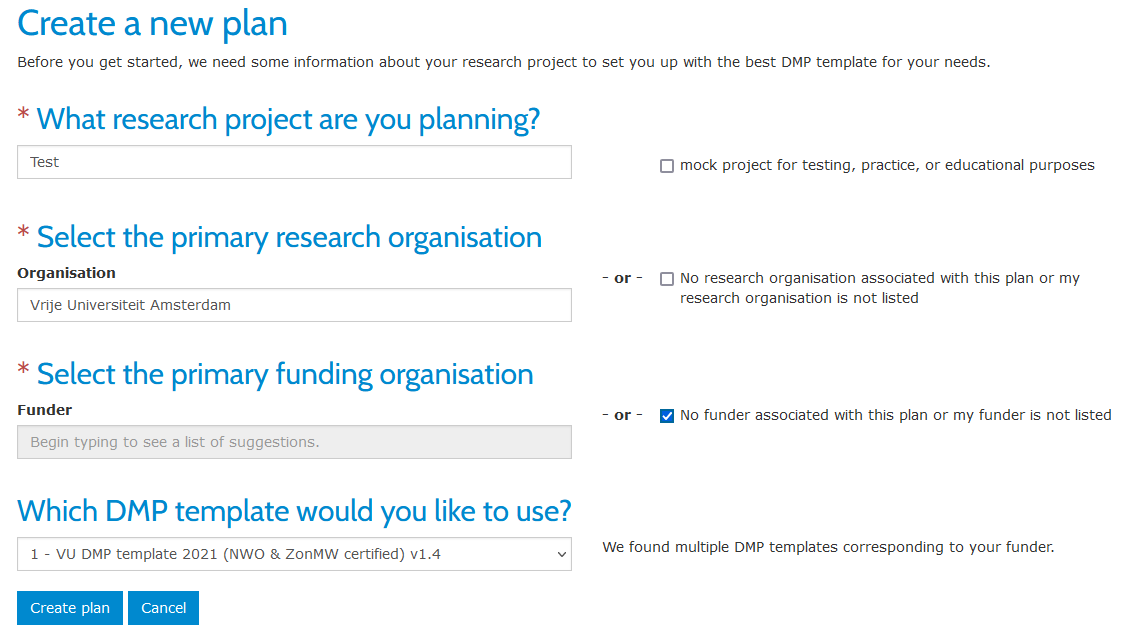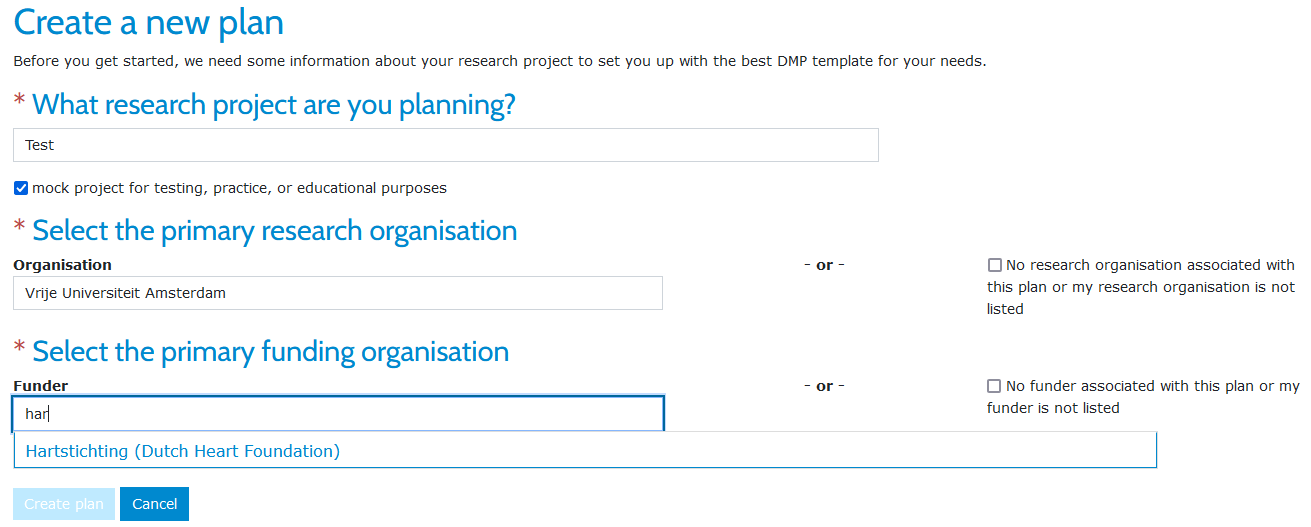Data Management Plan (DMP)
What is a DMP
A Data Management Plan (DMP) is a document outlining how research data will be handled throughout the research life cycle. A DMP is a structured way to address data collection, organization, storage, sharing, and preservation. It also outlines the measures taken to ensure data security and addresses how data will be preserved and made available for future use.
DMPonline
VU Amsterdam offers the online tool DMPonline for writing Data Management Plans. DMPonline is a platform that offers a range of templates, ensuring that researchers can create DMPs to meet the standards of diverse funders and institutions associated with their projects. DMPonline makes it easy to work on a DMP together with colleagues, advisors, or other stakeholders. VU Amsterdam researchers can use the request feedback function of DMPonline to get their DMP reviewed by a faculty data steward or RDM Support Desk colleague.
If you have questions about DMPonline, or encounter problems when using the tool, please get in touch with rdm@vu.nl.
Choosing the right template
Various templates exist in which you can set up your DMP. We strongly recommend that you use the VU template, which is called VU DMP template 2021 (NWO & ZonMw certified) v1.4. Below you’ll find an explanation of how to access this template. If you need to write a DMP for funding agencies NWO, ZonMw or ERC, you can use the VU template as well.
VU template
You can find the VU DMP template in DMPonline. It includes concise guidance on how to complete your DMP.
You can select the VU template by taking the following steps (see also the picture below).
- On your dashboard, click on
Create plan. - Enter the title of your research project (you don’t have to select the check box for mock testing).
- Select
Vrije Universiteit Amsterdamas your primary research organisation. - For the question on primary funding organisation, select the check box on the right, saying that no funder is associated with your plan.
Note: Follow these steps as well if you receive funding from NWO or ZonMw (see also below).

If you’re aiming to write a full DMP based on VU Amsterdam DMP template, please make sure you don’t select the GDPR registration form.

Funder template
We recommend researchers to use VU Amsterdam DMP template whenever possible, especially for researchers who work with personal data. The VU DMP template includes questions that serve as input for the GDPR record of processing activities. This means that when you write a DMP based on the VU DMP template, you simultaneousely comply with the VU requirement to register the personal data you use in your research.
However, it is also possible to use other templates in DMPonline. If your funder or partner organization requires you to use a certain template, it is possible to select that template in DMPonline. Please follow the steps below to select a funder’s template.
- On your dashboard, click on
Create plan. - Enter the title of your research project (you don’t have to select the check box for mock testing).
- Select
Vrije Universiteit Amsterdamas your primary research organisation. - In the field under
Select the primary funding organisation, start typing the name of your funder and select their template.

Researchers who don’t work with personal data and who wish to use another DMP template than the VU template, can also follow the steps above.
Register your processing activities
How does registration of personal data processing work in research?
If your research is subject to the GDPR, then you need to register information on your research in a central VU registry. This central registry lists all personal data processing activities carried out at VU Amsterdam. The registry indicates why and how personal data are processed, and with whom they are shared. The registry helps VU Amsterdam demonstrate compliance with the GDPR and in the case of a data breach, the registry helps with monitoring and acting swiftly to inform all relevant stakeholders.
For research projects, VU Amsterdam registers data processing via DMPonline. You can create your registration by logging into DMPonline and following the following instructions:
- On your dashboard, click on
Create plan. - Enter the title of your research project (you don’t have to select the check box for mock testing).
- Select
Vrije Universiteit Amsterdamas your primary research organisation. - For the question on primary funding organisation, select the check box on the right, saying that no funder is associated with your plan.

Once you get to the two VU templates, you can fill in the VU DMP template 2021 v1.4 if you need to write a DMP anyway; the information you include in this DMP template will be used for the registry. If you don’t need to write a (new) DMP, you can use the separate VU GDPR registration form for research v1.1. Your faculty’s 🔒 Privacy Champion can help you with your registration.
If your research is primarily led by Amsterdam UMC, location VUmc, your research will be registered using their own separate system.
Register before you start your data collection
If you use personal data in your research, you should register your data processing activities before you start data collection. If you are not sure whether your research data are subject to the GDPR, contact your faculty’s 🔒 Privacy Champion. Your privacy champion can also assist you if your research is already running, but has not yet been registered.
What is data
Research data is any information that has been collected, observed, generated or created to validate original research findings. Examples of data could be interview recordings, experiment results, physical measurement, notes from focus group’s meetings, notes from fieldwork, observations captured in photographs, film or audio, text files extracted from a corpus, image of archival items or artworks, scraped websites, responses to survey questions. Algorithms, simulations, code, scripts and software are often also considered as research data. There is also physical data: (biological) samples, collections, artifacts etc.
Administrative documents, like informed consent forms and key files should be acknowledged as important elements of research data as well.
Data Assets
At VU Amsterdam, we sometimes use the term ‘Data Assets’. You can think of data assets as small ‘parcels’ of data that can change form or format throughout the research. For example, if you’re sending out surveys for your research, the survey responses are considered a data asset. If, in addition to the surveys, you’re also holding focus groups, the data collected from the focus group are also considered a data asset, separate from the survey results. Most projects will have more than one data asset per data stage. It is common to provide data assets based on the data stage such as raw, processed, or analysed. Raw Data refers to original data collected, Processed Data is data that has undergone some level of transformation or organisation. Processing involves cleaning, formatting, and structuring raw data to make them more understandable and suitable for analysis. Analysed Data usually results from statistical methods, detailed examination or interpretation.
Here are some examples of data assets in research data management:
| Data Stage | Dataset description | Type of data | Format |
|---|---|---|---|
| Raw data | Interviews | Audio files | MP3 |
| Spectographic analysis | Text files | CSV | |
| Processed data | Transcription of interviews | Text files | Docx |
| Data spreadsheet | SPSS files | SAV | |
| Analysed data | Regression graphic | Graph | PNG |
| Data table | Word file | Docx | |
| Other | Poster presentation | Powerpoint | PPS |
| Project Website | HTML | ||
| Analysis code | Text files | Python |
Note that these data assets also change in the different phases of the research! While the interview data are audio files in the raw stage, they are transcribed and become text files in the processed stage.
DMP Elements
VU Amsterdam DMP template consists of seven sections with questions. In DMPonline, there is guidance available for all sections, as well as example answers. When you are writing your DMP, you can consult this information directly in DMPonline. Below we provide references to information and support available for various RDM-related aspects.
Legal and ethical requirements, codes of conduct
If you have questions about working with personal data in research, please get in touch with the Privacy Champion of your faculty. The 🔒 overview of Privacy Champions can be found on VU Amsterdam website. Make sure to contact your Privacy Champion in the following situations:
- If you need to carry out a DPIA, or if you’re unsure if you need to do one
- If you work with special category personal data, or otherwise very sensitive data
- If you are collaborating with other parties
- If you need software for which no licence is set up on behalf of VU Amsterdam
- If you wish to reuse existing data containing personal data
It is impossible to provide an overview of tasks to be carried out to ensure compliance with the GDPR that fits all research projects. For that reason, it is important to contact your Privacy Champion. They will be able to identify what needs to be arranged to adhere to the GDPR.
Ethical aspects of research should be addressed in the ethics procedure of your faculty. Each faculty has their own ethics committee. The webpages of all committees are listed below. Please go to the page of the ethics committee of your faculty to find instructions for ethical review procedures for your study.
- ACTA: ACTA Institutional Review Board (IRB)
- Beta: Research ethics review committee Faculty of Science (BETHCIE)
- FGB: 🔒 Scientific and Ethical Review Board (VCWE)
- FGW: Ethische Toetsingscommissie Onderzoek (EtCO)
- FSW: 🔒 Research Ethics Review Committee (RERC)
- RCH (Faculty of Law): Ethics Committee
- VUmc: METc (Medical Ethical Review Committee)
Storage and backup during the research process
An overview of storage facilities at VU Amsterdam is available in the Data Storage Finder. You can use this as a starting point to navigate storage solutions.
If you have questions about data storage and backup, send an email to rdm@vu.nl.
Data archiving and publishing
If your research data contains personal data and you’re unsure about which data may be published, please contact your 🔒 Privacy Champion.